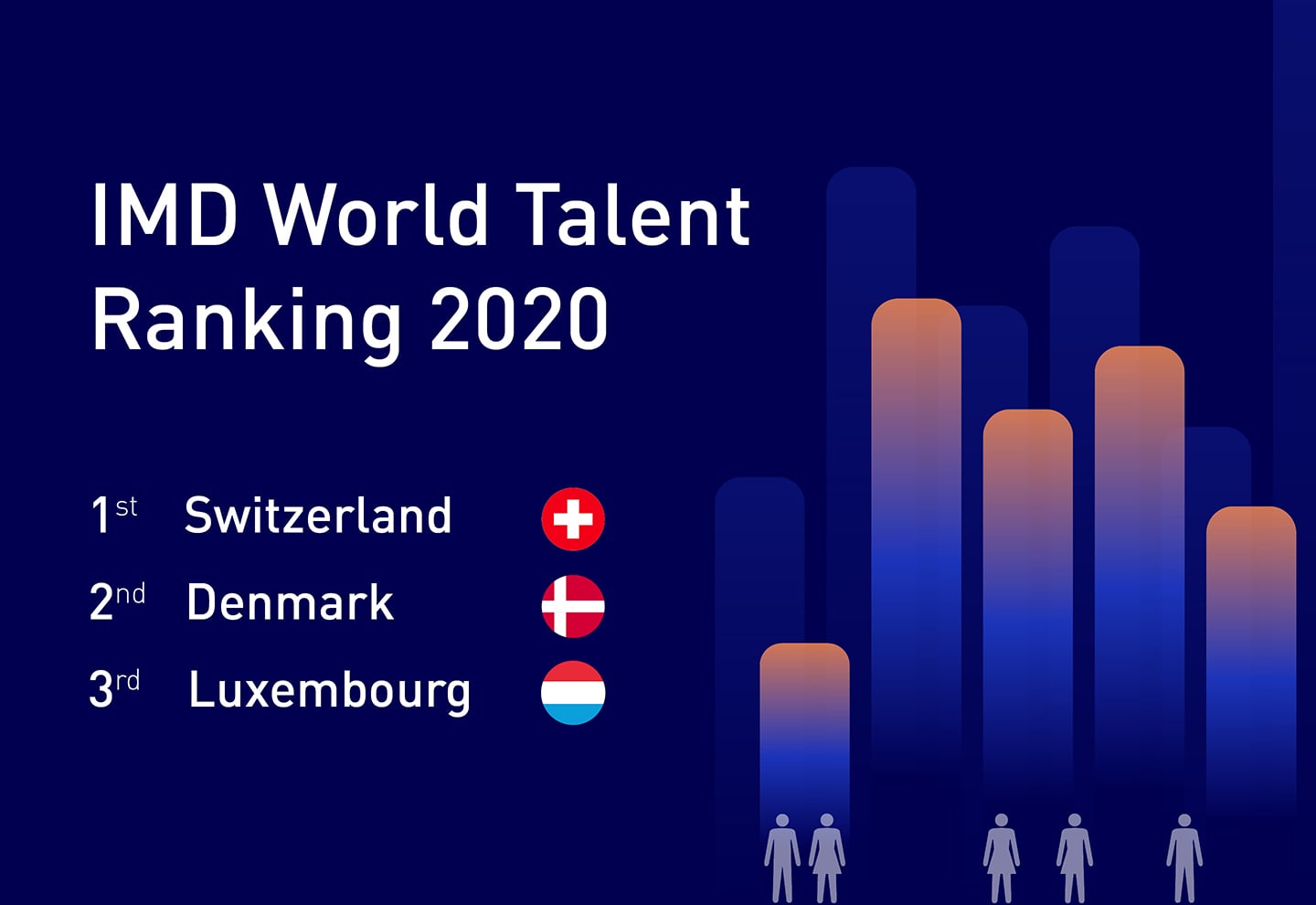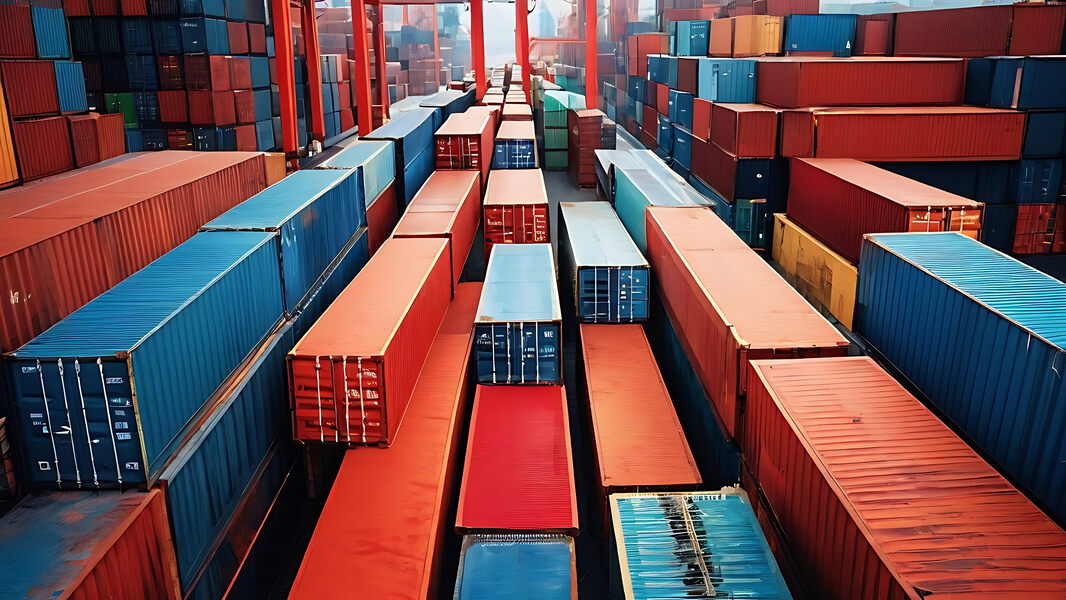
What drives an economy to be highly talent competitive?
In this edition of the IMD World Competitiveness Center’s Criterion of the Month, we outline three important insights:
- Talent competitive countries focus their talent development efforts in a holistic manner, balancing between academic rigor and vocational training to enhance the skills and competences needed.
- Their enterprises invest in keeping the workforce motivated — fundamental for sustaining productivity and thus for a smoother transition to a post-COVID-19 environment.
- They are economies that are open to the movement of people and ideas.
The IMD World Competitiveness Center’s World Talent Ranking assesses the extent to which economies are able to develop, attract and retain talent for enterprises operating in those economies.
To do so, the ranking evaluates three factors: how an economy fosters the domestic talent (‘investment and development’); the extent to which an economy retains homegrown talent and also draws from the international talent pool (‘appeal’); and the quality of the skills and competences that are available in the economy (‘readiness’).
In 2020, Switzerland and Denmark hold the first and second positions, respectively, for the sixth consecutive year. Luxembourg, Iceland and Sweden complete the five most competitive economies with respect to talent. Austria, Norway, Singapore and the Netherlands remain in the top ten positions with small fluctuations from last year while Canada moves five spots to become the eighth most talent competitive economy.
Figure 1 provides the list of the 15 highest-ranked economies in the 2020 ranking.
Figure 1. The 15 top performers in the 2020 IMD World Talent Ranking
Click here to see the full list of the 63 economies
Three areas are common to all economies that performed strongly in this year’s ranking. They concern (a) education, (b) the pandemic and (c) international talent.
An education system that has all bases covered
First, highly competitive countries focus their talent development efforts on every stage of the educational process. We can be sure of this because each year we measure criteria that capture the quality of education at all levels: primary, secondary and tertiary.
Furthermore, and still education-related, in the most competitive economies, mid- and high-level executives believe that apprenticeships are “sufficiently implemented” and the provision of employee training is a priority for companies.
Table 1 shows five areas we measure that encompass both academic and more vocational aspects.
In all these indicators, the best performers are countries that top the overall talent competitiveness rankings. What do we notice across the board?
- Governments, in addition to the funds allocated for education, are also building institutional frameworks for strong infrastructure, to facilitate apprenticeships and employee training.
- Executives perceive that universities and business schools “align their curricula to the needs of their economies”.
- Enterprises are contributing to the lifelong learning and reskilling of the labor force by prioritizing the need for employee training.
Table 1: Top- and under-performers in criteria related to education
Motivating the workforce pays off
The second trend in this year’s results is an indication of how the pandemic affected our lives in different ways. The loss of the workplace and the birth of a ‘place from where people work’ has been disruptive for many, not least because of the suddenness with which it occurred.
Throughout the world, those members of the labor force whose tasks can be accomplished remotely are working from home. There are different pros and cons for this reality.
However, as has been pointed out by different researchers, resilient enterprises are those that manage to balance performance KPIs with the motivation of their labor force. The latter is an important component in the sustainability of workers’ efforts when away from both the physical workplace and their co-workers.
The last row of Table 1 captures this trend: in the midst of the current crisis, economies that top the talent ranking are also those that executives perceive to have managed to keep the workforce continuously motivated.
Remaining attractive to the outside world
The final aspect that this year’s talent heavyweights have in common will come as no surprise: they appeal to an international talent pool. These countries are all open — both to the movement of people and ideas.
Figure 2 captures the relationship between the attitudes that society has towards globalization and the aforementioned appeal factor. It shows that despite its current somewhat restrictive immigration practices, the USA remains open and attractive to overseas talent and can retain the local component of the talent pool.
Figure 2: Relationship between openness and the ‘appeal’ factor (how well an economy retains homegrown talent and draws from the international talent pool) in the 2020 ranking
Other talent-competitive countries such as Switzerland, Luxembourg, Germany, Austria and Norway also show positive attitudes towards globalization and strong ‘appeal’.
As we edge closer to finding a vaccine, we should anticipate further disruption to the way we work and the relationship between our home space and our working environment.
Irrespective of the outcome, balancing academic rigor and vocational training to enhance skills and competences needed, keeping the workforce motivated and promoting frameworks that support the movement of people and ideas will remain necessary to the build domestic and international pools of talent of the future.
Research Information & Knowledge Hub for additional information on IMD publications

China's self-reliance, innovation & resilience under 'Made in China 2025' continue to shape its global role amid geopolitical tensions & policy challenges.

Your gut instinct matters in a data-driven world. IMD’s Heather Cairns-Lee & Eugene Sadler-Smith explain how intuition enhances decision-making in uncertainty.
With stagnant import volumes since 2021, and import prices at levels below those suggested by fundamentals, foreign exporters face an uphill battle to convert access to the Chinese market into revenues. Notably, the volume stagnation predates the ...

Early in his career, Dolf van den Brink did everything he could to project an image of authority – including wearing spectacles he didn’t need. It wasn’t until he learned to be comfortable in his skin that he began to excel as a leader, he tells ...
It has become conventional wisdom to view Europe as an economic powerhouse past its prime, overshadowed by the steady advance of the US and meteoric rise of China. Critics cite Europe’s shrinking share of global GDP, excessive regulation, and slug...
Now in its eighth year, the 2024 IMD World Digital Competitiveness Ranking measures the capacity and readiness of 67 economies to adopt and explore digital technologies as a key driver for economic transformation in business, government, and wider...

A balanced assessment of the past eight years is that, in terms of trade policy, America has turned protectionist, implementing significant measures to restrict domestic market access to foreign (non-US) imports.

Key minds behind the Hinrich-IMD Sustainable Trade Index – Deborah Elms, Chuin Wei Yap, Christos Cabolis, and Simon Evenett – explain how decision-makers can benefit from looking at industrial policy in granular detail, given its resurgence and th...
Inflows of foreign direct investment into China shows worrying trends despite its massive economy. While total FDI appears substantial at $163B in 2023, most growth comes from existing foreign subsidiaries rather than new entrants. Foreign manufac...

Climate change, geopolitical frictions, and supply chain disruptions call for more sustainable trade practices that can withstand the pressures of volatility. But for trade to be sustainable, it must also be resilient. IMD World Competitiveness Ce...
Research Information & Knowledge Hub for additional information on IMD publications
Research Information & Knowledge Hub for additional information on IMD publications
Research Information & Knowledge Hub for additional information on IMD publications
Research Information & Knowledge Hub for additional information on IMD publications
Research Information & Knowledge Hub for additional information on IMD publications
IMD World Competitiveness Center Report, 14 November 2024, 8th edition
Research Information & Knowledge Hub for additional information on IMD publications
Research Information & Knowledge Hub for additional information on IMD publications
Research Information & Knowledge Hub for additional information on IMD publications
Research Information & Knowledge Hub for additional information on IMD publications
Research Information & Knowledge Hub for additional information on IMD publications

